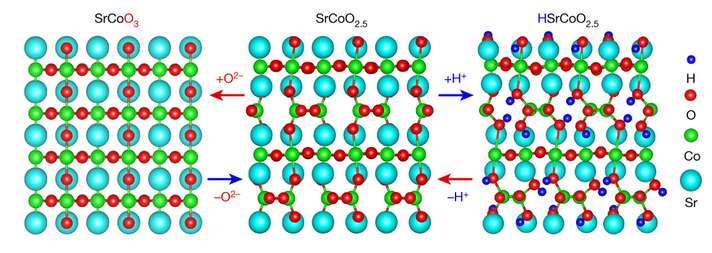June 1, 2017 report
A material that can switch between multiple phases that have distinct electronic, optical and magnetic properties

(Phys.org)—A large team of researchers with members from China, the U.K., the U.S. and Japan has developed a material that can switch between multiple phases with distinct electronic, optical and magnetic properties. In their paper published in the journal Nature, the team describes how they made their material, how it can be caused to switch properties and possible uses for it. Shriram Ramanathan, with Purdue University offers a News & Views piece on the work done by the team in the same journal issue and adds some additional background on the search for functional materials.
As Ramanathan points out, humans have been searching for functional materials for centuries—we want more out of our materials than simply bearing loads. As he further notes, many such materials have been developed due to clearly directed efforts, but some have also come about by changing a material that has already been discovered. In this new effort, the researchers have taken the latter approach—they have modified an existing material to make it more useful by causing it to have different properties depending on how it is used.
To create the new material, the researchers created a thin layer of ceramic material in the traditional way, on top of a substrate. But instead of cooking it, as has been done historically, they covered the surface of the material with an ionic gel-like liquid. To provide for additional functionality, the liquid was an electrical insulator and able to conduct ions. It also held dissolved oxide ions and hydrogen ions. When electricity was applied to the material, the result depended on the polarity of the voltage—ions from either the hydrogen or oxide ions were driven into the ceramic material below. Reversing the voltage induced the reverse, which quite obviously meant that the system was reversible, as well.
The researchers report that the system works at room temperature and that analysis with magnetic probing and X-ray diffraction showed the phases of the material to be distinct. They also demonstrated one application of the material as a means for altering the transmissivity of light through a sheet of glass. Ramanathan suggests such a material could have a wide range of uses, particularly as a base for research work being done by other groups.
More information: Nianpeng Lu et al. Electric-field control of tri-state phase transformation with a selective dual-ion switch, Nature (2017). DOI: 10.1038/nature22389
Abstract
Materials can be transformed from one crystalline phase to another by using an electric field to control ion transfer, in a process that can be harnessed in applications such as batteries, smart windows and fuel cells. Increasing the number of transferrable ion species and of accessible crystalline phases could in principle greatly enrich material functionality. However, studies have so far focused mainly on the evolution and control of single ionic species (for example, oxygen, hydrogen or lithium ions). Here we describe the reversible and non-volatile electric-field control of dual-ion (oxygen and hydrogen) phase transformations, with associated electrochromic2 and magnetoelectric11 effects. We show that controlling the insertion and extraction of oxygen and hydrogen ions independently of each other can direct reversible phase transformations among three different material phases: the perovskite SrCoO3−δ, the brownmillerite SrCoO2.5, and a hitherto-unexplored phase, HSrCoO2.5. By analysing the distinct optical absorption properties of these phases, we demonstrate selective manipulation of spectral transparency in the visible-light and infrared regions, revealing a dual-band electrochromic effect that could see application in smart windows. Moreover, the starkly different magnetic and electric properties of the three phases—HSrCoO2.5 is a weakly ferromagnetic insulator, SrCoO3−δ is a ferromagnetic metal, and SrCoO2.5 is an antiferromagnetic insulator—enable an unusual form of magnetoelectric coupling, allowing electric-field control of three different magnetic ground states. These findings open up opportunities for the electric-field control of multistate phase transformations with rich functionalities.
Journal information: Nature
© 2017 Phys.org





















